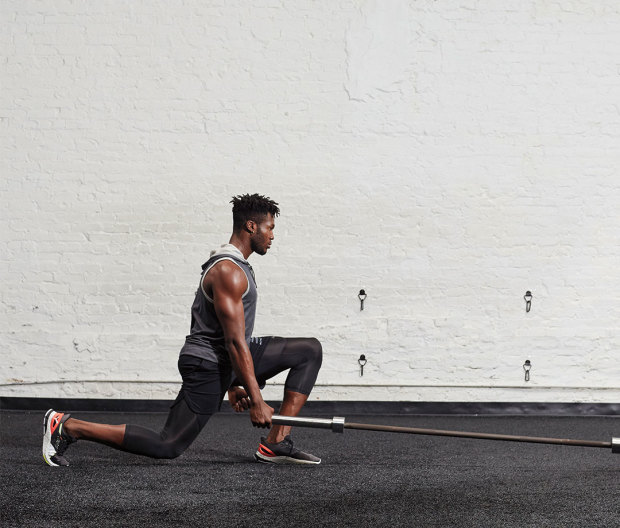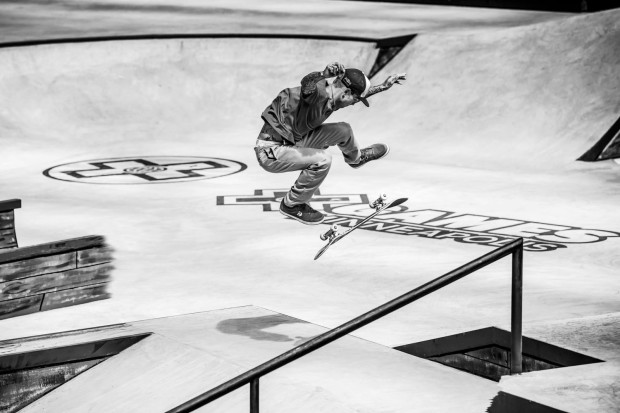When we interviewed Ryan Sheckler in 2014 as part of our Game Changers feature, we profiled the fearless skater at the helm of skateboarding’s fitness revolution.
“Everything I do right now, it’s all preventive measures,” he said in the 2014 interview. “If I do get a really hard slam, my body can handle it; I’m strong enough to get back up and try it again. I roll with the punches.”
The phenom hasn't just been rolling with the punches. He's been hurling his body down stairs, flying over rails, and across countless other obstacles for our viewing pleasure.
w in his 30s, Sheckler has amassed an impressive array of feats and injuries to match, including a fractured vertebrae and two broken ankles in what he calls the fall that made him question his career. (He's still alive and walking, so we'd say his body is handling it just fine.)
Sheckler shares what it's like to recover from an injury as a professional athlete in the new Red Bull documentary Rolling Away, which offers a more personal glimpse into Sheckler's life since we last watched him on MTV's Life of Ryan.
In present day, we sat down with Sheckler to see how his training regimen has evolved in the last decade.
In our 2014 interview, he said: “Everything we do is for the core, for heart rate, and for speed and power. There’s a little bit of weight training, but it’s mostly body weight.”
Ten years later, he's shouldering more weight, but the goal remains the same: boost performance and stay skating for longer.
Interview has been edited for length and clarity. As told by Charles Thorp.
Courtesy Image
Men's Journal: How long have you taken training seriously?
Ryan Sheckler: I’ve been training hard since I was 16 years old, and there were people in the skateboarding community that looked down on me for it. The fact that I had a trainer, was going into the gym, working out on the beach, and doing these long road bike rides didn’t fit what everyone else was doing—or, more accurately, wasn’t doing. But for me, it seemed intuitive to train hard, especially when we’re doing events like the Mountain Dew Tour where we’re doing three 15-minute jams, which equates to 45 minutes of intense skateboarding.
I knew I needed to build up the cardio to be able to do that. Being strong throughout the entire competition was clutch, because those last 15 minutes are commonly the most important ones. That’s when I stored power. I looked for a trainer, and specifically found a motocross trainer, Johnny Louch, because I wanted someone who understood the level of endurance required. Since his whole focus was helping motocross riders find the strength to finish these long, brutal races, I knew it would fit what I needed. Once we started working together I only lost three competitions over the course of five years. I was winning the championship every single year because of my training.
You don't always think of skateboarders strength training. How does it help and hinder your abilities?
It has backfired before, because you don’t need to be the strongest person in the world to skateboard. In fact, in some cases it’s a detriment to be bigger and have more weight to deal with while in the air. On top of that, it takes more to get off the ground. But that didn’t stop me. For some reason I still needed to have a 300-pound deadlift. w I train much more appropriately for the sport I do. I still lift heavy weights, but I’m doing it in less traditional ways that mimic how my body moves in the air during tricks. That way, when I take impact while doing tricks, my body is much more prepared to deal with the force that happens on those landings.
I was up to 180 pounds recently, and I felt strong, but it wasn’t conducive to my skateboarding. My body was too rigid. Because of that, I lost 10 pounds, so I’m still heavier than I’ve been before, but in a middle ground where I can move well. This is my sweet spot. I’m explosive but still have the power I want to put out there when I’m skating. I find that it helps me mentally, too—feeling strong when I’m looking at a track.
Related: 50 Best Leg Exercises of All Time to Build Muscle
I’ve always had wide shoulders, so I like to lean into that. I consider working on my shoulders, arms, and everything else as armor-building. It’s not specifically going to make me a better skater, but it’s giving me more strength to deal with the physical punishment from runs. The most important element for me is my core. I need to have that strong. Those are the muscles that are going to really control and affect my spine. There are a lot of times when you're in the air, moving your body for a trick, where you're in that crunch position.
How does your training adjust leading into a trick attempt or competition?
I would run on the beach at full power for 15 minutes, doing these zigzags in the sand and changing directions quickly. I do that to keep my bones and muscles used to those forces. I wanted to get used to being uncomfortable. I wanted to put myself through more strain and more stress than I would be feeling in competition. So that when I was competing everything felt easier than what I was already used to, and not way worse. I always had extra fuel in the tank. Running your training harder than you ever are going to need helps you keep composure in those more intense moments.
Once we got to the competition I was ready to do these intense 15-minute jams and I wasn’t even breathing hard when everyone else was pushing themselves to the limit. There were other skaters next to me who would be breathing hard, even throwing up in the heat. But I wasn’t even bothered. I wouldn’t outright say that I’m better than anyone, but I definitely train harder than anyone. Once you hit this level of skateboarding, where people are competing in international competitions, any of those pros can win at any time if they find their moment. So that training gave me an edge in a lot of situations.
Related: How Many Sets and Reps You Should Do for Training Goals
What do you think is the most beneficial exercise for skateboarders?
Right now I’m doing landmines almost in a curtsy, with the bar loaded heavy, and what I’ve noticed with that is that it’s really opening up my hips. I’ve been having issues over the years with my hips. Probably because when I fall, most of the time my right hip takes the brunt of the punishment. I’ve had to learn how to fall with the least amount of damage, because if you’re a skateboarder pushing the limits, you're going to fall a lot. There’s no real way to avoid damage entirely.
If I didn’t learn the right way to fall, my body probably would just have exploded during some of these attempts. My hips would have been absolutely destroyed, but even falling the best way possible, over time it adds up. So these exercises I’m doing are based around reopening and strengthening my hips. There's so much necessary power for skateboarding that comes from the glutes, hamstrings, and quads.

Landmine reverse lunge: the perfect primer to a landmine curtsy lunge
Justin Steele
How to Do a Landmine Curtsy Lunge
Pro Tips
- The first time, start with an empty bar. It already weighs 45 pounds. As you get more comfortable, increase the weight in increments of five to 10 pounds.
- Begin with a reverse lunge (shown above) to familiarize yourself with moving in tandem with the barbell, then advance to a curtsy lunge.
- If you don't have a landmine setup in your gym, wedge a barbell into the corner of a room with towels to protect the walls.
How to Do It
- Stand facing a landmine (it's a heavy metal base with a sleeve meant to fit the end of a barbell) with no weight plates, to start.
- Grab the end of the barbell in your right hand, neutral grip, both arms extended along torso.
- Take a large step back with your right leg, crossing it behind your left (as if you’re about to do a curtsy). Your weight should be in your left foot as you slowly bend your knees, lowering your body straight down.
- Stop once your working leg is parallel to the floor, keeping your core braced and torso tall.
- Push through your working leg to rise to the starting position. That's 1 rep.
- Do all reps on right side, then switch.

